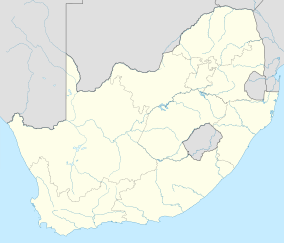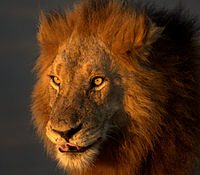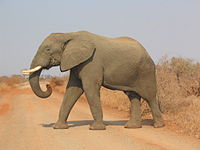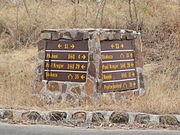
Kruger National Park
About this schools Wikipedia selection
The articles in this Schools selection have been arranged by curriculum topic thanks to SOS Children volunteers. SOS Child sponsorship is cool!
| Kruger National Park | |
|---|---|
|
IUCN category II ( national park)
|
|
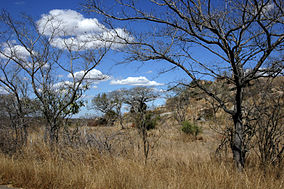 Landscape in the Kruger National Park |
|
| Location of the park | |
| Location | Limpopo and Mpumalanga provinces, South Africa |
| Nearest city | Nelspruit, South Africa |
| Coordinates | 24°0′41″S 31°29′7″E Coordinates: 24°0′41″S 31°29′7″E |
| Area | 19,485 km2 (7,523 sq mi) |
| Established | May 31, 1926 |
| Visitors | 1,336,981 (in 2004) |
| Governing body | South African National Parks |
| Official website | |
Kruger National Park is one of the largest game reserves in Africa. It covers 19,485 square kilometres (7,523 sq mi) and extends 360 kilometres (220 mi) from north to south and 65 kilometres (40 mi) from east to west.
To the west and south of the Kruger National Park are the two South African provinces of Limpopo and Mpumalanga. In the north is Zimbabwe, and to the east is Mozambique. It is now part of the Great Limpopo Transfrontier Park, a peace park that links Kruger National Park with the Gonarezhou National Park in Zimbabwe, and with the Limpopo National Park in Mozambique.
The park is part of the Kruger to Canyons Biosphere, an area designated by the United Nations Education and Scientific Organisation (UNESCO) as an International Man and Biosphere Reserve (the "Biosphere").
The park has 9 main gates that allow entrance to the different camps.
The park is the site of the popular eyewitness viral video Battle at Kruger.
History
Sabi Game Reserve (1898 - 1926)
In 1895, Jakob Louis van Wyk introduced in the Volksraad of the old South African Republic, a motion to create the game reserve which would become the Kruger National Park. That motion, introduced together with another Volksraad member by the name of R. K. Loveday, and accepted for discussion in September 1895 by a majority of one vote, resulted in the proclamation by Paul Kruger president of the Transvaal Republic, on March 26, 1898, of a “Government Wildlife Park.” This park would later be known as the Sabi Game Reserve and was expanded into the Kruger National Park in 1926.
The park was initially created to control hunting and protect the diminished number of animals in the park.
James Stevenson Hamilton became the first warden of the reserve in 1902. The reserve was located in the southern one-third of the modern park. Shingwedzi Reserve, now in northern Kruger National Park, was proclaimed in 1903. In 1926, Sabie Game Reserve, the adjacent Shingwedzi Game Reserve, and farms were combined to create Kruger National Park.
During 1923, the first large groups of tourists started visiting the Sabie Game Reserve, but only as part of the South African Railways' popular "Round in Nine" tours. The tourist trains used the Selati railway line between Komatipoort on the Mozambican border and Tzaneen in Limpopo Province. The tour included an overnight stop at Sabie Bridge (now Skukuza) and a short walk, escorted by armed rangers, into the bush. It soon became a highlight of the tour and it gave valuable support for the campaign to proclaim the Sabie Game Reserve as a national park.
1926 - 1946
After the proclamation of the Kruger National Park in 1926, the first three tourist cars entered the park in 1927, jumping to 180 cars in 1928 and 850 cars in 1929.
Warden James Stevenson-Hamilton retired on the 30th April 1946, after 44 years as warden of the Kruger Park and its predecessor, the Sabi Game Reserve.
1946 - 1994
He was replaced by Colonel J. A. B. Sandenburg of the South African Air Force. During 1959, work commenced to completely fence the park boundaries. Work started on the southern boundary along the Crocodile River and in 1960 the western and northern boundaries were fenced, followed by the eastern boundary with Mozambique. The purpose of the fence was to curb the spread of diseases, facilitate border patrolling and inhibit the movement of poachers.
The Makuleke area in the northern part of the park was forcibly taken from the Makuleke people by the government in 1969 and about 1500 of them were relocated to land to the South so that their original tribal areas could be integrated into the greater Kruger National Park.
1994 - present
In 1996 the Makuleke tribe submitted a land claim for 19,842 hectares (198.42 km2) in the northern park of the Kruger National Park. The land was given back to the Makuleke people, however, they chose not to resettle on the land but to engage with the private sector to invest in tourism, thus resulting in the building of several game lodges.
In 2002, Kruger National Park, Gonarezhou National Park in Zimbabwe, and Limpopo National Park in Mozambique were incorporated into the a peace park, the Great Limpopo Transfrontier Park.
Geography
Geography of the Kruger National Park
The park lies in the north-east of South Africa, in the eastern parts of Limpopo and Mpumalanga provinces. Phalaborwa, Limpopo is the only town in South Africa that borders the Kruger National Park. It is one of the largest national parks in the world, with an area of 19,485 square kilometres (7,523 sq mi) The park is approximately 360 kilometres (220 mi) long, and has an average width of 65 kilometres (40 mi). At its widest point, the park is 90 kilometres (56 mi) wide from east to west. To the north and south of the park two rivers, the Limpopo and the Crocodile respectively, act as its natural boundaries. To the east the Lebombo Mountains separate it from Mozambique. Its western boundary runs parallel with this range, roughly 65 km distant. The park varies in altitude between 200 m in the east and 840 m in the south-west near Berg-en-Dal. The highest point in the park is here, a hill called Khandzalive. Several rivers run through the park from west to east, including the Sabie, Olifants, Crocodile, Letaba, Luvuvhu and Limpopo rivers.
Climate
| Skukuza | ||||||||||||||||||||||||||||||||||||||||||||||||||||||||||||
|---|---|---|---|---|---|---|---|---|---|---|---|---|---|---|---|---|---|---|---|---|---|---|---|---|---|---|---|---|---|---|---|---|---|---|---|---|---|---|---|---|---|---|---|---|---|---|---|---|---|---|---|---|---|---|---|---|---|---|---|---|
| Climate chart ( explanation) | ||||||||||||||||||||||||||||||||||||||||||||||||||||||||||||
|
||||||||||||||||||||||||||||||||||||||||||||||||||||||||||||
|
||||||||||||||||||||||||||||||||||||||||||||||||||||||||||||
The climate of the Kruger National Park and Lowveld is subtropical. Summer days are humid and hot with temperatures often soaring to above 38 °C (100 °F). The rainy season is from September until May. The dry winter season is the ideal time to visit this region for various reasons. There is less chance of contracting malaria and the days are milder. Viewing wildlife is more rewarding as the vegetation is more sparse and animals are drawn to the waterholes to drink every morning and evening.
Flora and fauna
Vegetation
Plant life in the park consists of four main areas:
Thorn Trees and Red Bush-willow veld
This area lies between the western boundary and roughly the centre of the park south of the Olifants River. Combretums, such as the red bush-willow (Combretum apiculatum), and Acacia species predominate while there are a great number of marula trees (Sclerocarya caffra). The Acacias are dominant along the rivers and streams, the very dense Nwatimhiri bush along the Sabie River between Skukuza and Lower Sabie being a very good example.
Knob-thorn and Marula Veld
South of the Olifants River in the eastern half of the park, this area provides the most important grazing-land. Species such as red grass (Themeda triandra) and buffalo grass (Panicum maximum) predominate while the knob-thorn (Acacia nigrescens), leadwood (Combretum imberbe) and marula (Sclerocarya caffra) are the main tree species.
Red Bush-willow and Mopane Veld
This area lies in the western half of the park, north of the Olifants River. The two most prominent species here are the red bush-willow (Combretum apiculatum) and the mopane tree (Colophospernum mopane).
Shrub Mopane Veld
Shrub mopane covers almost the entire north-eastern part of the park.
There are a number of smaller areas in the park which carry distinctive vegetation such as Pretoriuskop where the sickle bush and the silver cluster-leaf (Terminalia sericae) are prominent. The sandveld communities near Punda Maria are equally definitive, with a wide variety of unique species.
Birds
Out of the 517 species of birds found at Kruger, 253 are residents, 117 non-breeding migrants, and 147 nomads.
Mammals
All the Big Five game animals are found at Kruger National Park, which has more species of mammals than any other African Game Reserve (at 147 species). There are webcams set up to observe the wildlife.
The park stopped culling elephants in 1989 and tried translocating them, but by 2004 the population had increased to 11,670 elephants, by 2006 to approximately 13,500 and by 2009 to 11,672. The park's habitats can only sustain about 8,000 elephants. The park started using annual contraception in 1995, but has stopped that due to problems with delivering the contraceptives and upsetting the herds.
Kruger supports packs of the endangered African Wild Dog, of which there are thought to be only about 400 in the whole of South Africa.
Kruger National Park holds over 48 tons of ivory in storage. According to Convention on the International Trade in Endangered Species of Wild Flora and Fauna (CITES), it is allowed to sell 30 tons.
Following approval by CITES, 47 metric tons of stockpiled ivory from Kruger were auctioned on November 6, 2008. The sale fetched approximately US$6.7 million which will be used towards increasing anti-poaching activity. The average price for the 63 lots on auction was US$142/kg.
| Species | Count | Species | Count |
|---|---|---|---|
| African Buffalo | 27,000 | African Wild Dog | 350 |
| Black Rhinoceros | 350 | White Rhinoceros | 7,000 to 12,000 |
| Burchell's Zebra | 17,797 | Bushbuck | 500 |
| Cheetah | 200 | Common Eland | more than 300 |
| Giraffe | 5,114 | Greater Kudu | 5,798 |
| Hippopotamus | 3,000 | Lion | 1,500 |
| Leopard | 1,000 | Spotted Hyena | 2,000 |
| Elephant | 11,672 | Waterbuck | 5,000 |
| Blue Wildebeest | 9,612 | Impala | 90,000 |
Reptiles
Kruger houses 114 species of reptile, including black mamba and 3000 crocodiles.
Amphibians and fishes
Thirty-three species of amphibians are found in the Park, as well as 50 fish species. A Zambesi shark, Carcharhinus leucas, also known as the bull shark, was caught at the confluence of the Limpopo and Luvuvhu Rivers in July 1950. Zambezi sharks tolerate fresh water and can travel far up rivers like the Limpopo.
Accommodation
The Kruger National Park has 21 rest camps, as well as 2 private lodge concessions, and 15 designated private safari lodges. The concessions are parcels of land operated by private companies in partnership with communities, who outsource the operation of private lodges.
Rest camps
- Bateleur Bushveld Camp
- Berg-en-Dal Camp, near Malelane Gate.
- Biyamiti Bushveld Camp
- Boulders Bush Lodge
- Balule Private Camp, near Olifants Camp.
- Crocodile Bridge Camp, near Crocodile Bridge Gate.
- Letaba Camp
- Lower Sabie Camp
- Malelane Private Camp, Malelane Gate.
- Maroela Private Camp, near Orpen Gate.
- Mopani Camp
- Olifants Camp
- Orpen Camp, near Orpen Gate.
- Pretoriuskop Camp, near Numbi Gate.
- Punda Maria Camp, near Punda Maria Gate
- Roodewal Bush Lodge
- Satara Camp
- Shimuwini Bushveld Camp
- Shingwedzi Camp
- Sirheni Bushveld Camp
- Skukuza Camp, not far from Paul Kruger Gate.
- Talamati Bushveld Camp
- Tamboti Tented Camp, near Orpen Gate .
- Tsendze Rustic Camp
Designated Private Lodges
- Camp Shawu near Crocodile Bridge Gate .
- Camp Shonga near Crocodile Bridge Gate .
- Hamiltons Tented Camp
- Hoyo Hoyo Tsonga Lodge
- Imbali Safari Lodge
- Jocks Safari Lodge & Spa
- Lukimbi Safari Lodge
- Pafuri Camp, near Pafuri Gate .
- Plains Camp
- Rhino Post Camp
- Shishangeni Lodge near Crocodile Bridge Gate .
- Singita Lebombo Lodge
- Singita Sweni Lodge
- The Outpost Lodge, near Pafuri Gate.
- Tinga Game Lodges
Gates to the Kruger Park
The Kruger Park has the following gates:
| Name | Road | From Town | Coordinates | Remarks |
|---|---|---|---|---|
| Crocodile Bridge Gate | on the extension of Rissikstreet | from Komatipoort | 25°21′30.48″S 31°53′36.59″E | |
| Malelane Gate | on the R570 off the N4 | near Malelane | 25°27′42.73″S 31°31′58.70″E | |
| Numbi Gate | on the R569 road | from Hazyview | 25°9′19.26″S 31°11′51.00″E | |
| Phabeni Gate | on the road off the R536 | from Hazyview | 25°1′30.42″S 31°14′29.15″E | |
| Paul Kruger Gate | on the R536 road | from Hazyview | 24°58′52.70″S 31°29′6.92″E | |
| Orpen Gate | on the R531 road | from Klaserie | 24°28′32.95″S 31°23′26.79″E | |
| Phalaborwa Gate | on the R71 road | from Phalaborwa | 23°56′43.63″S 31°9′54.15″E | |
| Punda Maria Gate | on the R524 road | from Thohoyandou | 22°44′17.89″S 31°0′32.52″E | |
| Pafuri Gate | on the R525 road | from Musina | 22°24′0.60″S 31°2′29.08″E |
Wilderness trails
Nine different trails are on offer in the Kruger National Park. Some are overnight and they last several days in areas of wilderness virtually untouched by humans. There are no set trails in the wilderness areas; a visitor walks along paths made by animals or seeks out new routes through the bush.
